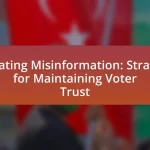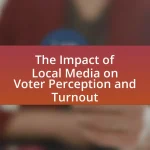Targeted ads in political elections are advertisements tailored to specific voter segments using demographic, behavioral, and psychographic data to enhance campaign effectiveness. This article analyzes the differences between targeted and traditional advertising, the technologies enabling targeted ads, and the role of data analytics in optimizing voter engagement. It also explores the importance of targeted ads in influencing voter behavior, the methods for measuring their effectiveness, and the challenges and ethical considerations surrounding their use. Key metrics such as click-through rates and conversion tracking are discussed, along with strategies for improving future targeted ad campaigns.
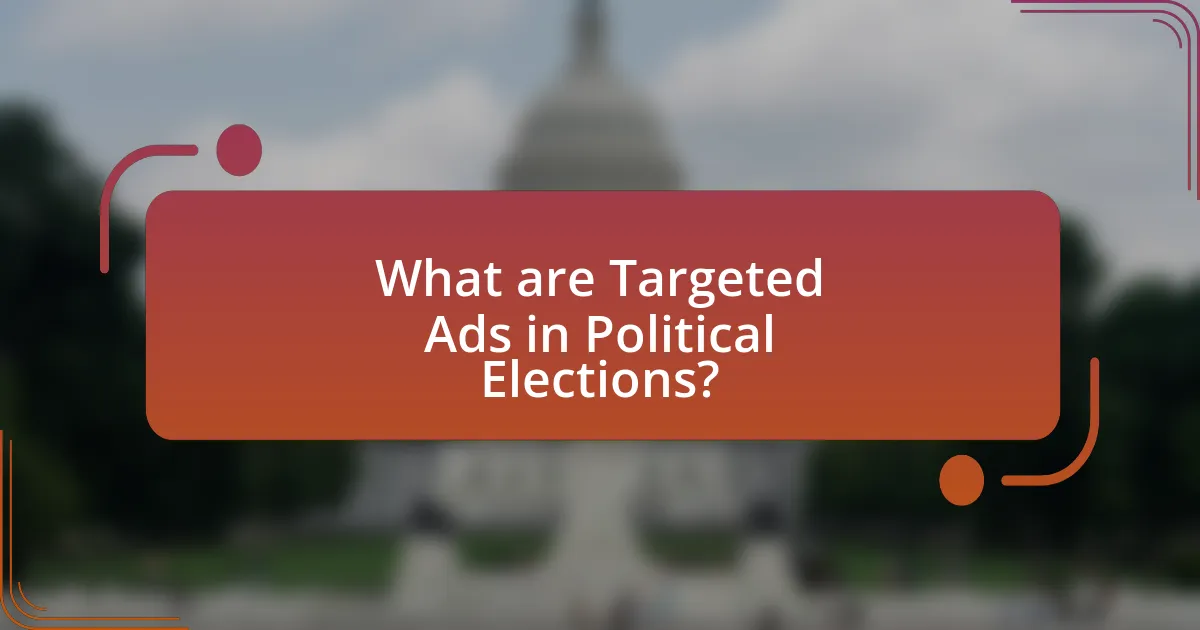
What are Targeted Ads in Political Elections?
Targeted ads in political elections are advertisements specifically designed to reach particular segments of the electorate based on demographic, behavioral, and psychographic data. These ads utilize data analytics to identify and engage voters who are most likely to support a candidate or cause, thereby increasing the efficiency and effectiveness of campaign messaging. For instance, during the 2016 U.S. presidential election, campaigns employed targeted ads on social media platforms, leveraging user data to tailor messages that resonated with specific voter groups, which contributed to the overall strategy of voter mobilization and persuasion.
How do Targeted Ads differ from Traditional Advertising?
Targeted ads differ from traditional advertising primarily in their ability to reach specific audiences based on data-driven insights. Traditional advertising typically employs a broad approach, using mass media channels like television, radio, and print to reach a wide audience without precise targeting. In contrast, targeted ads leverage user data, such as online behavior, demographics, and interests, to deliver personalized messages to individuals most likely to engage with the content. For example, a study by the Pew Research Center found that 72% of consumers prefer targeted ads because they are more relevant to their interests, highlighting the effectiveness of this approach in engaging potential voters during political elections.
What technologies enable Targeted Ads in political campaigns?
Technologies that enable targeted ads in political campaigns include data analytics, social media platforms, programmatic advertising, and machine learning algorithms. Data analytics allows campaigns to gather and analyze voter data, identifying demographics and preferences. Social media platforms, such as Facebook and Twitter, provide tools for precise audience targeting based on user behavior and interests. Programmatic advertising automates the buying and placement of ads, optimizing reach and engagement in real-time. Machine learning algorithms enhance targeting by predicting voter behavior and preferences based on historical data, improving ad effectiveness. These technologies collectively enhance the ability of political campaigns to reach specific voter segments with tailored messages.
How do data analytics play a role in Targeted Ads?
Data analytics significantly enhance targeted ads by enabling precise audience segmentation and personalized messaging. Through the analysis of vast datasets, including user behavior, demographics, and preferences, advertisers can identify specific groups most likely to engage with their content. For instance, a study by the Pew Research Center found that targeted ads can increase engagement rates by up to 50% compared to non-targeted ads. This data-driven approach allows political campaigns to allocate resources more effectively, ensuring that messages resonate with the intended audience, ultimately improving the overall effectiveness of advertising strategies in elections.
Why are Targeted Ads important in Political Elections?
Targeted ads are important in political elections because they enable campaigns to reach specific voter demographics with tailored messages. This precision increases the likelihood of engagement and persuasion, as ads can be customized based on factors such as age, location, interests, and voting history. For instance, during the 2016 U.S. presidential election, targeted advertising played a crucial role, with campaigns utilizing data analytics to identify and influence key voter segments, resulting in a more effective allocation of resources and messaging strategies. Studies have shown that targeted ads can significantly enhance voter turnout and support, demonstrating their critical role in modern electoral strategies.
What impact do Targeted Ads have on voter engagement?
Targeted ads significantly enhance voter engagement by delivering personalized messages that resonate with specific demographics. Research indicates that campaigns utilizing targeted advertising can increase voter turnout by up to 10%, as these ads effectively address the interests and concerns of individual voters. For instance, a study by the Pew Research Center found that 70% of social media users reported seeing political ads tailored to their preferences, which led to increased discussions about candidates and issues among peers. This tailored approach not only captures attention but also fosters a sense of relevance, motivating voters to participate in elections.
How do Targeted Ads influence voter behavior and decision-making?
Targeted ads significantly influence voter behavior and decision-making by delivering personalized messages that resonate with individual preferences and concerns. Research indicates that these ads can increase voter engagement by tailoring content to specific demographics, thereby enhancing the likelihood of voter turnout. For instance, a study by the Pew Research Center found that 70% of social media users reported seeing political ads that were relevant to their interests, which can sway opinions and mobilize voters. Additionally, targeted ads can reinforce existing beliefs, as they often present information that aligns with users’ prior views, leading to confirmation bias. This strategic use of data analytics allows campaigns to effectively allocate resources and maximize impact, ultimately shaping electoral outcomes.
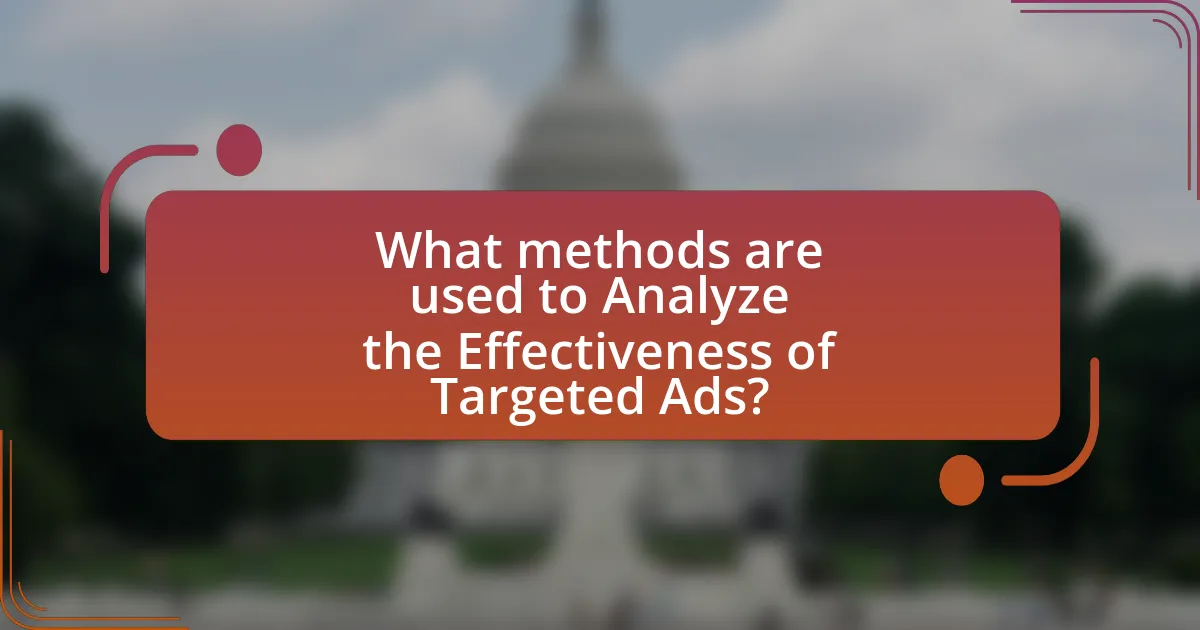
What methods are used to Analyze the Effectiveness of Targeted Ads?
Methods used to analyze the effectiveness of targeted ads include A/B testing, conversion tracking, and audience segmentation analysis. A/B testing allows marketers to compare two versions of an ad to determine which performs better based on specific metrics such as click-through rates or conversions. Conversion tracking measures the actions taken by users after interacting with an ad, providing insights into its impact on desired outcomes. Audience segmentation analysis involves breaking down the audience into distinct groups to evaluate how different segments respond to targeted ads, enabling more tailored and effective advertising strategies. These methods collectively provide a comprehensive understanding of how targeted ads influence voter behavior and engagement in political elections.
What metrics are commonly used to measure effectiveness?
Common metrics used to measure effectiveness in analyzing targeted ads in political elections include click-through rates (CTR), conversion rates, engagement rates, and return on investment (ROI). Click-through rates indicate the percentage of users who click on an ad after seeing it, providing insight into ad appeal. Conversion rates measure the percentage of users who take a desired action, such as donating or signing up, after interacting with the ad, reflecting the ad’s ability to drive action. Engagement rates assess how users interact with the ad content, including likes, shares, and comments, which can indicate the ad’s resonance with the audience. Return on investment quantifies the financial return generated from the ad campaign relative to its cost, allowing for a clear evaluation of overall effectiveness. These metrics are essential for understanding the impact of targeted advertising strategies in political contexts.
How do click-through rates reflect the success of Targeted Ads?
Click-through rates (CTR) serve as a key metric for evaluating the success of targeted ads by indicating the percentage of users who engage with the ad after it is displayed. A higher CTR suggests that the ad resonates well with the intended audience, reflecting effective targeting and messaging. For instance, a study by WordStream found that the average CTR for targeted ads in the political sector can reach up to 5%, significantly higher than the average of 1.91% for display ads across all industries. This data illustrates that when ads are tailored to specific demographics and interests, they are more likely to capture attention and drive user action, thereby demonstrating the effectiveness of targeted advertising strategies in political campaigns.
What role does conversion tracking play in evaluating Targeted Ads?
Conversion tracking is essential for evaluating targeted ads as it measures the effectiveness of ad campaigns by tracking specific actions taken by users after interacting with the ads. This process allows advertisers to determine which ads lead to desired outcomes, such as donations or volunteer sign-ups, thereby providing concrete data on return on investment (ROI). For instance, a study by the Interactive Advertising Bureau found that campaigns utilizing conversion tracking can increase conversion rates by up to 30%, demonstrating its critical role in optimizing ad strategies and improving overall campaign performance in political elections.
How can surveys and feedback be utilized in analysis?
Surveys and feedback can be utilized in analysis by collecting quantitative and qualitative data that reflects voter perceptions and attitudes towards targeted ads in political elections. This data allows analysts to measure the effectiveness of specific advertising strategies, identify voter demographics that respond positively or negatively, and assess overall campaign impact. For instance, a study by the Pew Research Center found that 70% of voters reported being influenced by targeted ads, highlighting the importance of understanding voter feedback in shaping future advertising efforts. By systematically analyzing survey results, campaigns can refine their messaging and improve engagement with key voter segments.
What questions should be included in surveys to assess Targeted Ads?
To assess targeted ads in political elections, surveys should include questions that evaluate ad recall, perceived relevance, and behavioral impact. Specific questions may include: “Do you remember seeing any political ads recently?” to gauge recall; “How relevant do you find the political ads you see?” to assess perceived relevance; and “Did any of the ads influence your voting decision?” to measure behavioral impact. These questions are essential as they directly relate to the effectiveness of targeted advertising strategies in influencing voter behavior, supported by studies indicating that ad recall and relevance significantly affect voter engagement and decision-making.
How can qualitative feedback enhance understanding of ad effectiveness?
Qualitative feedback enhances understanding of ad effectiveness by providing in-depth insights into audience perceptions and emotional responses. This type of feedback reveals the motivations behind viewer reactions, allowing marketers to identify which elements of an ad resonate most strongly with the target demographic. For instance, a study by the American Marketing Association found that qualitative insights can uncover nuances in consumer attitudes that quantitative data may overlook, such as the emotional impact of a political ad on voter sentiment. By analyzing these insights, political campaigns can refine their messaging and strategies to better align with voter concerns and preferences, ultimately improving ad effectiveness.
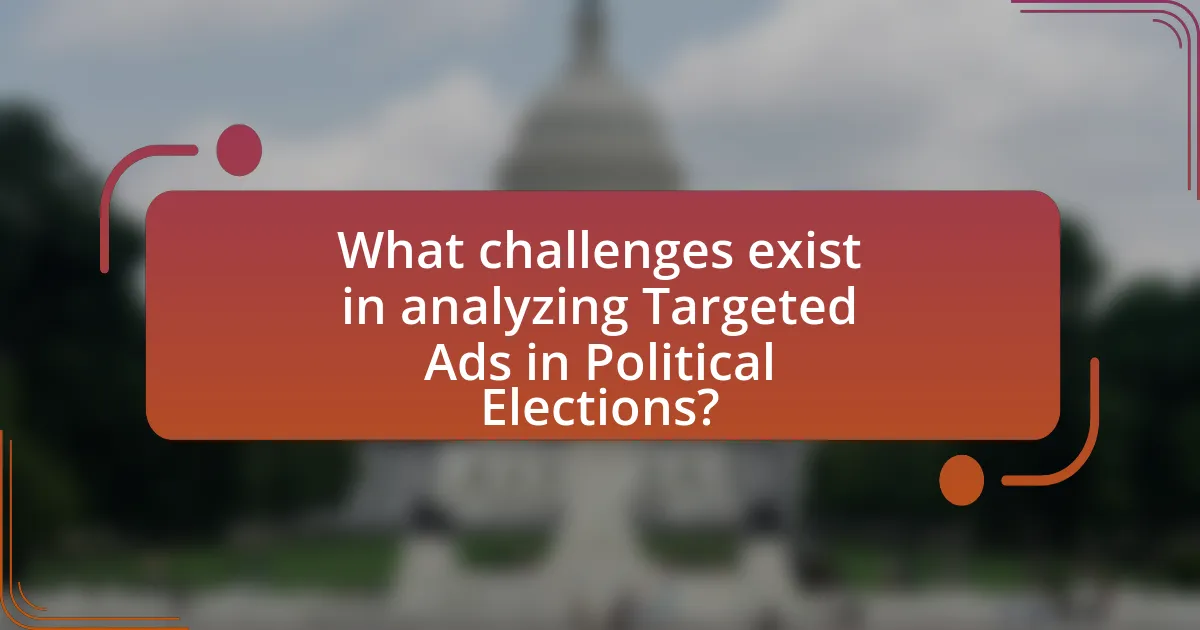
What challenges exist in analyzing Targeted Ads in Political Elections?
Analyzing targeted ads in political elections presents several challenges, primarily due to data privacy issues, the complexity of audience segmentation, and the difficulty in measuring ad effectiveness. Data privacy regulations, such as the General Data Protection Regulation (GDPR), restrict access to user data, making it challenging for analysts to gather comprehensive insights on ad reach and engagement. Additionally, audience segmentation is often based on algorithms that may not accurately reflect voter behavior, leading to potential misinterpretations of ad impact. Furthermore, measuring the effectiveness of targeted ads is complicated by the lack of standardized metrics and the influence of external factors, such as media coverage and public sentiment, which can skew results. These challenges hinder the ability to draw definitive conclusions about the effectiveness of targeted ads in influencing voter behavior.
What ethical considerations must be taken into account?
Ethical considerations in analyzing the effectiveness of targeted ads in political elections include the potential for misinformation, privacy concerns, and the manipulation of voter behavior. Misinformation can mislead voters, impacting their decision-making processes, as evidenced by studies showing that false information spreads more rapidly on social media platforms. Privacy concerns arise from the collection and use of personal data without informed consent, which violates individuals’ rights and can lead to distrust in the electoral process. Additionally, the manipulation of voter behavior through targeted ads can create echo chambers, reinforcing existing biases and undermining democratic discourse. These factors highlight the need for ethical guidelines to ensure transparency, accountability, and respect for individual rights in political advertising.
How does data privacy impact the use of Targeted Ads?
Data privacy significantly impacts the use of targeted ads by limiting the amount of personal information that advertisers can collect and utilize for ad personalization. Regulations such as the General Data Protection Regulation (GDPR) and the California Consumer Privacy Act (CCPA) impose strict guidelines on data collection, requiring explicit consent from users and providing them with rights to access and delete their data. These legal frameworks restrict advertisers’ ability to track user behavior across platforms, which diminishes the effectiveness of targeted ads. For instance, a study by the Interactive Advertising Bureau (IAB) found that 70% of marketers reported challenges in targeting audiences due to privacy regulations, leading to a decrease in ad relevance and engagement rates.
What are the implications of misinformation in political advertising?
Misinformation in political advertising undermines democratic processes by distorting public perception and influencing voter behavior. This distortion can lead to the spread of false narratives, which may sway undecided voters and reinforce biases among supporters. For instance, a study by the Pew Research Center found that 64% of Americans believe fabricated news stories cause confusion about basic facts, impacting electoral outcomes. Additionally, misinformation can erode trust in legitimate media sources and institutions, further polarizing the electorate and complicating informed decision-making.
How can biases affect the analysis of Targeted Ads?
Biases can significantly distort the analysis of targeted ads by skewing the interpretation of data and influencing decision-making processes. For instance, confirmation bias may lead analysts to favor data that supports pre-existing beliefs about the effectiveness of certain ads, while ignoring contradictory evidence. Additionally, selection bias can occur when the sample of users exposed to targeted ads is not representative of the broader population, resulting in misleading conclusions about the ads’ overall impact. Research indicates that these biases can lead to overestimations of ad effectiveness, as seen in studies where political campaigns misinterpret engagement metrics due to biased data analysis.
What types of biases are most common in political advertising analysis?
The most common biases in political advertising analysis include confirmation bias, framing bias, and selection bias. Confirmation bias occurs when analysts favor information that supports their pre-existing beliefs about a candidate or issue, leading to skewed interpretations of ad effectiveness. Framing bias arises when the presentation of information influences perceptions, such as emphasizing certain aspects of a candidate’s platform while downplaying others. Selection bias happens when the sample of ads analyzed is not representative of the overall advertising landscape, resulting in misleading conclusions about their impact. These biases can significantly distort the understanding of how targeted ads perform in political elections.
How can analysts mitigate biases in their evaluations?
Analysts can mitigate biases in their evaluations by employing structured methodologies such as blind assessments and diverse team compositions. Blind assessments reduce the influence of personal biases by anonymizing data, allowing analysts to focus solely on the content and effectiveness of targeted ads without preconceived notions. Diverse team compositions bring varied perspectives, which can challenge individual biases and lead to more balanced evaluations. Research indicates that diverse teams are more effective at problem-solving and decision-making, as they incorporate a wider range of viewpoints, thereby enhancing the accuracy of evaluations in political advertising contexts.
What best practices should be followed when analyzing Targeted Ads?
When analyzing targeted ads, it is essential to follow best practices such as defining clear objectives, segmenting the audience, and utilizing data analytics tools. Clear objectives guide the analysis by establishing what metrics to focus on, such as engagement rates or conversion rates. Segmenting the audience allows for a more tailored approach, ensuring that the analysis reflects the diverse preferences and behaviors of different voter groups. Utilizing data analytics tools, such as Google Analytics or social media insights, provides concrete data that can reveal trends and patterns in ad performance. These practices are supported by research indicating that targeted ads can increase engagement by up to 50% when properly analyzed and optimized.
How can campaign managers effectively interpret data from Targeted Ads?
Campaign managers can effectively interpret data from targeted ads by utilizing analytics tools to assess engagement metrics, conversion rates, and audience demographics. These metrics provide insights into how well the ads resonate with specific voter segments, allowing managers to adjust strategies accordingly. For instance, a study by the Pew Research Center indicates that targeted ads can increase voter engagement by up to 20% when tailored to specific demographics. By analyzing click-through rates and demographic data, campaign managers can identify which messages are most effective and refine their outreach efforts to maximize impact.
What strategies can improve the effectiveness of future Targeted Ads?
Utilizing data-driven personalization significantly enhances the effectiveness of future targeted ads. By leveraging user data, such as browsing history and demographic information, campaigns can tailor messages that resonate with specific audiences. Research indicates that personalized ads can lead to a 20% increase in engagement rates compared to non-personalized ads. Additionally, employing A/B testing allows for the optimization of ad content and placement, ensuring that the most effective variations are used. According to a study by the Interactive Advertising Bureau, targeted ads that are continuously optimized based on performance metrics yield a 30% higher return on investment. Therefore, implementing data-driven personalization and A/B testing are proven strategies to improve the effectiveness of targeted ads in political elections.

